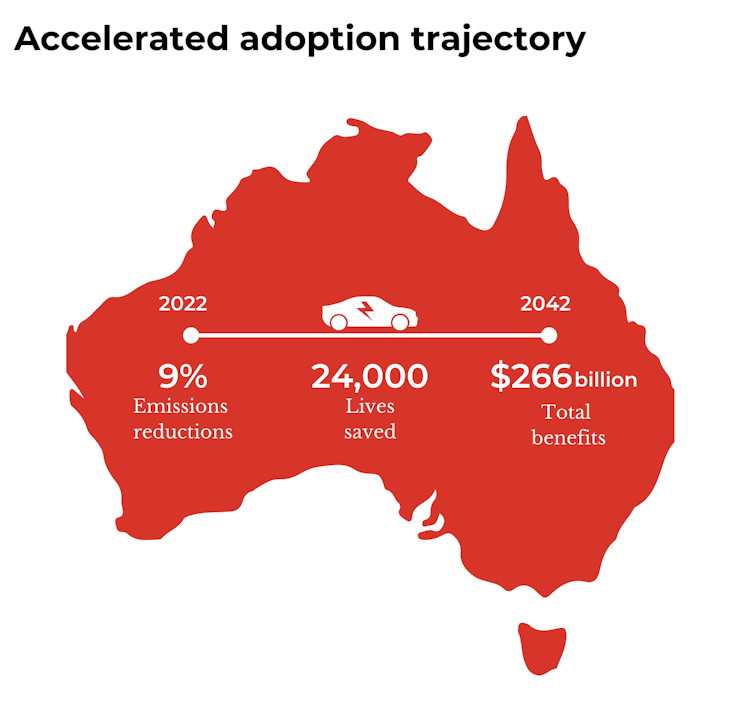A rapid shift to electric vehicles can save 24,000 lives over the next two decades

In summary
Analysis for The Conversation by Professor Hussein Dia, Associate Professor Andi Nygaard, Dr Krysztof Dembek and Associate Professor Magnus Moglia
Reducing air pollution from road transport will save thousands of lives and improve the health of millions of Australians. One of the quickest ways to do this is to accelerate the current slow transition to electric vehicles.
Our newly published research evaluated the costs and benefits of a rapid transition. In one scenario, Australia matches the pace of transition of world leaders such as Norway. Our modelling estimates this would save around 24,000 lives by 2042. The resulting greenhouse emission reductions over this time would almost equal Australia’s current total annual emissions from all sources.
We also calculated the total costs and benefits through to 2042. Australia would be about A$148 billion better off overall with a rapid transition.
Air pollution causes thousands of deaths
Every year, around 2,600 deaths in Australia are attributed to fine-particle air pollution. The main sources of this pollution are transport and industrial activities such as mining and energy generation.
An estimated 1,715 deaths were attributed to vehicle exhaust emissions in 2015. This was 42% more than the road toll that year.
Vehicle emissions increase respiratory infections as well, particularly in young children. Transport pollution contributes to many diseases, including lung cancer, heart disease, pneumonia, asthma and diabetes. It has also been linked to Alzheimer’s disease.
A 2019 study by the Electric Vehicle Council and Asthma Australia found vehicle emissions had 21,000 serious health impacts each year in New South Wales alone.
A Grattan Institute study last month showed exhaust-pipe pollutants from trucks kill more than 400 Australians every year.

Cities around the world have imposed bans on polluting trucks to reduce the harm to public health. Shutterstock
The benefits greatly outweigh the costs
Our new Swinburne University of Technology research evaluated the benefits of a transition to electric vehicles by considering public health, household and emissions reductions savings. We compared the benefits with costs, including charging infrastructure outlay, higher purchase prices for electric vehicles and green energy package costs – for household solar panels, battery storage and charging points.
Each electric vehicle was considered to have been bought along with a green energy package. The package minimises emissions and demands on electricity grid capacity, while increasing the benefits for households.
The study explored three scenarios:
slow scenario – business-as-usual, with electric vehicle sales increasing slowly from the current rate (a 5% increase in the first year, followed by a 10% yearly increase)
accelerated market-based scenario – aligns with the highest rates of adoption around the world like those in Norway (where 64% of new vehicles sold in 2021 were battery-powered), increasing by 5% every year
aggressive regulatory scenario – assumes all new vehicle sales would be electric in the base year as a result of government regulation.
The main differences between the scenarios are the rate of electric vehicle uptake (once consumers decide to retire their current vehicles) and the degree of government intervention.

The research found the business-as-usual scenario undermines national efforts to reduce the loss of life and cut emissions. It also found the aggressive strategy would have to overcome massive barriers given Australia trails many other countries in adopting electric vehicles.
The accelerated adoption strategy, however, is well aligned with uptake in other nations. Their example shows it can be achieved using progressive policies and incentives.
If implemented, the accelerated scenario could reduce the loss of life by around 24,000 by 2042. The reduction in emissions over this time would be 444 million tonnes of carbon dioxide equivalent, or 91% of Australia’s emissions from all sources in 2021. The cost would be around $118 billion, less than half of the total benefits of $266 billion.
Putting us on track for emissions targets
The new Climate Change Act mandates targets of a 43% cut in emissions by 2030 and net-zero emissions by 2050. Our research shows effective electric vehicle policies can help achieve these targets.
Such policies can be adopted from nations that have made rapid progress on electrifying their transport sectors. These policies include strict and mandatory fuel efficiency standards, investment in electric vehicle charging stations and standardisation of charging infrastructure. They also include financial incentives to buy and run electric vehicles, and cheap loans to help households and freight operators with purchase costs.
Importantly, these nations recognise that electric vehicles are not a remedy for all transport challenges. They should be complemented by strategies to manage travel demand, reduce the numbers of cars and journeys by car, and improve access to public transport.
We shouldn’t accept so many avoidable deaths
Without a rapid shift to electric vehicles, Australia risks losing at least 1,200 lives a year – deaths that we could avoid – over the next 20 years.
The loss of life would be equivalent to six planes, each carrying 200 passengers, falling out of the sky every year and killing everyone on board. We don’t accept this in air travel, and we should not accept the loss of life to preventable air pollution.
Australia has a feasible rapid pathway to decarbonise its transport sector. Our findings show the benefits to society and the planet are hard to dismiss.
This article was originally published on The Conversation.
-
Media Enquiries
Related articles
-

- Student News
- Science
- Sustainability
Introducing tomorrow’s global science communicators
Start Talking is Swinburne’s unique video-based public speaking competition, exclusively for undergraduate students
Monday 08 December 2025 -

- Astronomy
- Technology
- Health
- Science
- University
- Sustainability
- Engineering
Swinburne highly cited researchers reach the top in 12 fields
Ten Swinburne academics have been named on the Highly Cited Researchers 2025 list, released by Clarivate
Tuesday 02 December 2025 -

- Sustainability
Swinburne achieves carbon neutral certification
Swinburne has reached a major milestone in our sustainability journey - we are officially certified as carbon neutralThursday 20 November 2025 -

- Sustainability
Threatened by a damning climate future, women in leadership could save Australia’s tourism and hospitality sector, research finds.
New Swinburne research found that women leaders aid better environmental policies, resource use, lower emissions, and drive environmental innovation..
Monday 13 October 2025 -

- Science
Finding new life in dead solar panels
Swinburne University of Technology will lead a $3 million effort to save dead solar panels from landfill through a zero-carbon recycling process.
Wednesday 15 October 2025

